Stiletto nails: technique and interesting design ideas

Stiletto nails either come into fashion or are rapidly losing their relevance. The pointed shape requires from the wearer neat wear and appropriate dressing style.
Ten years ago, long stilettos were fashionable, now girls who choose this shape to decorate the free edge of the nail often stop at short stilettos.
Growing and wearing natural nails of this form is quite problematic., therefore, stilettos are built up - both with gel and with acrylic. It is important to remember that building-up should be done only on a healthy, even nail without any defects. And this should only be done by a high-class nail service master who has sufficient practice and skills.
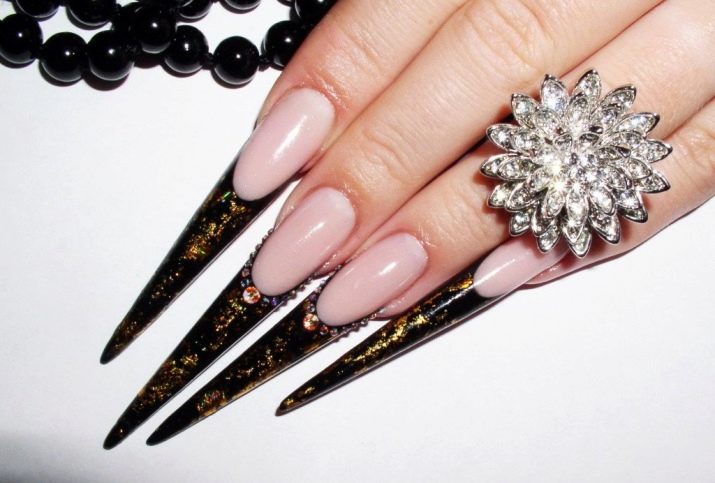
Views
Nail service specialists distinguish several types of stylet nails.
- "Pica" Is perhaps the most famous form. It is the most pointed of all, so it is perfect for owners of wide nails who want to make them more graceful. It should be borne in mind, however, that the “spikes” are very capricious to wear and break easily.
- Faceted stilettos - the most difficult form to execute. Each face is ground to be symmetrical to the rest. This shape is very difficult to build up and usually time consuming.
- "Gothic" - less sharp than the "lance", but more symmetrical and graceful. It is also difficult to perform, however, it looks very sophisticated.
- "Sword" - an intermediate form between "gothic" and "lance", also very graceful.
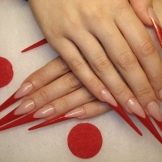
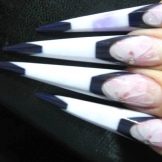
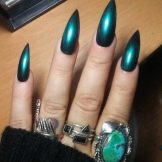
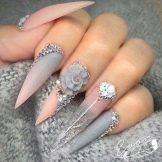
Advantages and disadvantages
Like any other shape, stiletto nails have their advantages.
- This form of sawdust on the free edge immediately draws attention to the hands.Therefore, for those women who seek to demonstrate their pens in a favorable light, stilettos are very suitable.
- "Spades" and "swords" always look unusual, not trivial. They are chosen by women who do not like boredom and monotony.
- A huge selection of designs due to the rather long (even with short "peaks") free edge will also appeal to ladies who like to change their manicure often.
- Ideal for wide nails, visually "stretch" them and make them more graceful.


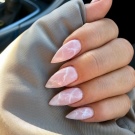
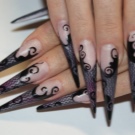

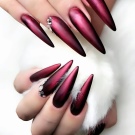
In addition to the listed advantages, stilettos have a number of disadvantages.
- Not suitable for ladies who cannot wear long nails. Because of the sharpened edges, "pikes" cling to clothes, tights, hair and jewelry, it is inconvenient to carry out routine household chores with them.
- This form of the free edge is very traumatic for the nail, as a rule, if it breaks, then “under the root”. The stress-zone of the stylets is located directly at the beginning of the free edge, which means that if the nail goes “corrugated” as a result of engaging something solid or traumatic bending of the nail plate, breakage will occur “with meat”. It looks unaesthetic and feels extremely painful.
- Definitely not suitable for lovers of manicure classics, who will probably find this form vulgar and flashy.
- Girls with long fingers or deformed phalanges should choose a different form of sawdust, as stilettos will draw attention to hand defects.
- Young mothers, as well as women working with children (kindergartens, primary grades), need to be very careful about such a shape for themselves, since the sharp edges of the nails can easily injure the delicate skin of the child. It is better to choose something safer, for example, a soft square or so fashionable now "almond".
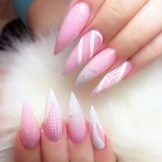
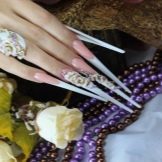
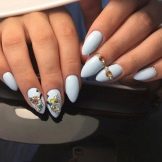
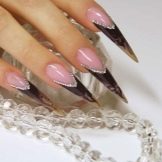
Design options
For stylet nails, all the same design options are applicable as for the rest of the free edge shapes. Monochrome finish - glossy or matte, two-tone combination or rubbed in - everything will look great. Classic French manicure will look fresh due to the unusual shape of the sawdust, especially if it is a "gothic" or "faceted" stiletto.

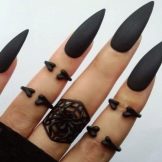
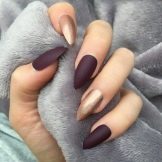

Complex designs - with elements of molding, casting, "liquid stones" - can also be made on this form, however, the number of elements should not be overused. It is better to select one or two nails in this way, leaving the rest solid. The abundance of details can "kill" the shape of the stylet, making it vulgar and lurid.
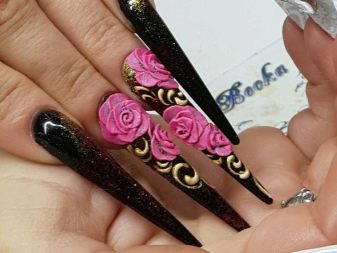
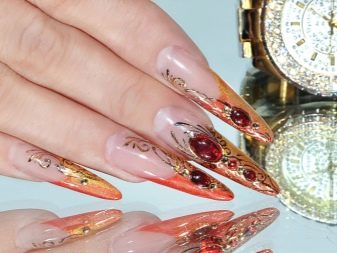
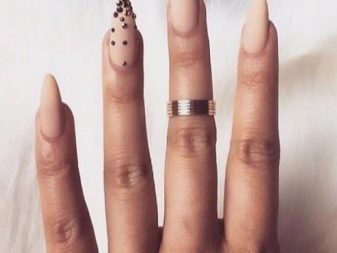

Monograms or geometry look original on stylets, made in a beige and black design with small splashes of sparkles: golden, silver or iridescent. Even fans of minimalism can safely wear "swords" or "Gothic" - just try one of the most trendy today "manicure without manicure", a "naked" nail with one design element, and a low-contrast, nude scale.

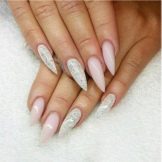

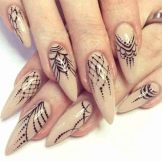
Another of the trends launched by nail bloggers this season is the "moon" manicure, in which only the hole is varnished, a transparent base and top are applied to the rest of the surface of the nail plate. This option can look quite unusual on stiletto nails, without making them too flashy, but certainly drawing attention to the hands.

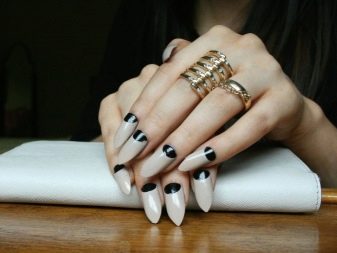
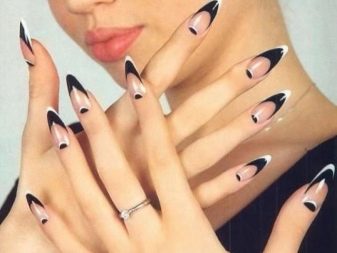
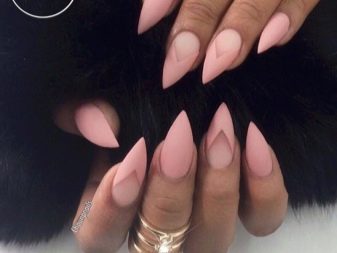
Regarding the color scale, stilettos are universal - any seasonal tones, be it wine and pumpkin yellow in autumn or neon pink and cornflower blue in summer, will look good on them. Also, the saturation of the tone does not matter - pale blue or mint is no less effective on the "peaks" than Marsala or chocolate.

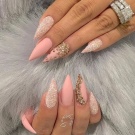

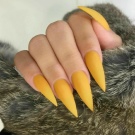
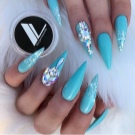

How to build up
Once again, I would like to draw your attention to the fact that only a nail service master can competently build up nails in the form of stylets made of gel or acrylic. You should not do this at home without knowledge and practice. In addition, it is undesirable to contact the masters whose professional skills you doubt.
Since stilettos are a rather long form of sawdust, you need to carefully approach the choice of materials for building and decorating nails. In search of cheaper services, you can not only "get off" with poor-quality manicure (this is the lesser of evils), but also get serious diseases of the nail plates and subsequently treat them for a long time.
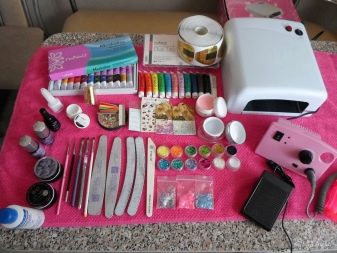
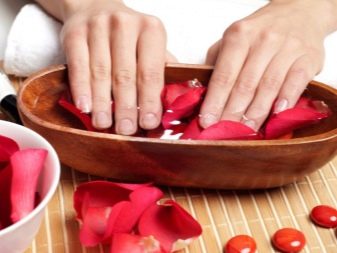
We remind you that during the period of nail restoration, no manicure, except for a therapeutic one, is acceptable.
Step-by-step nail extension in the form of a "stiletto" includes the following steps.
- It is necessary to perform a regular manicure (edging or hardware).
- A special paper template is attached to each of the fingers.
- A so-called primer is applied to the entire surface of the natural nail plate, which adheres the acrylic or gel to the nail.
- After drying in a lamp, spread the desired shape and length on the nails. This happens with acrylic or gel.
- When the nails are "laid out" and thoroughly dried, the paper templates are removed and filing is started. On each finger, the free edge of the nail plate should have the same shape and length.
- Perform the desired design.
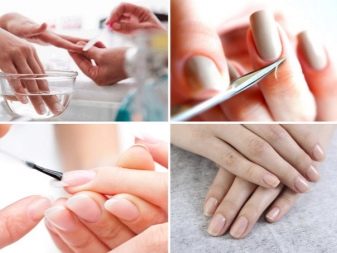
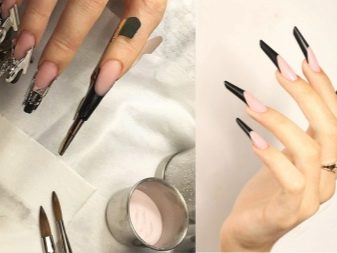
For the extension of stylets with gel, see the next video.








